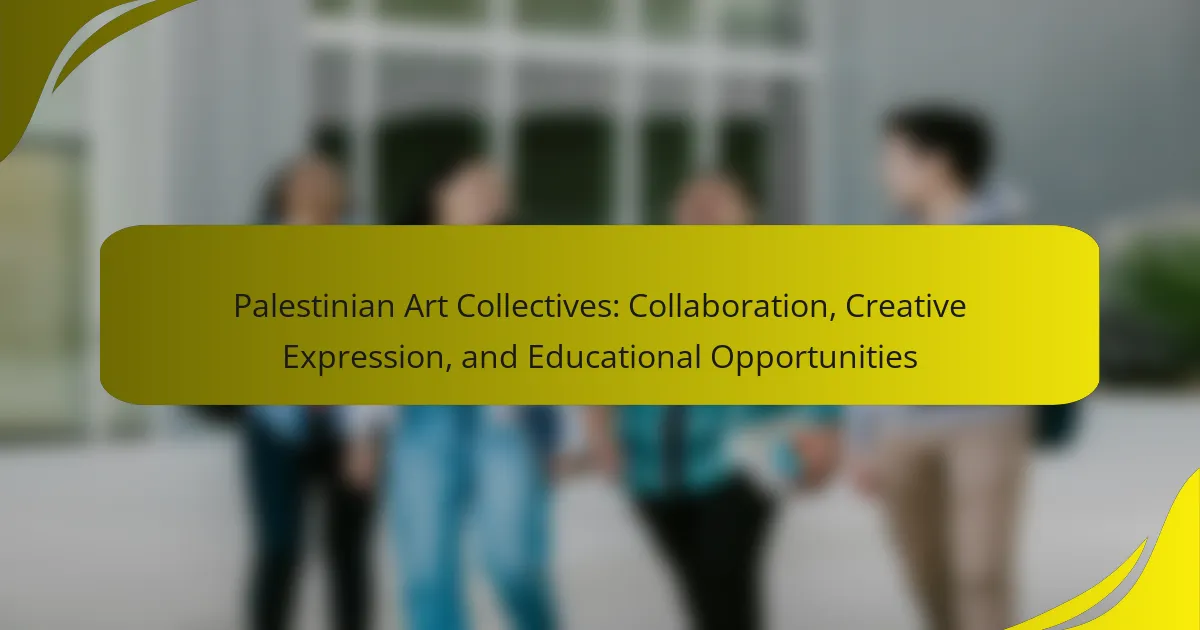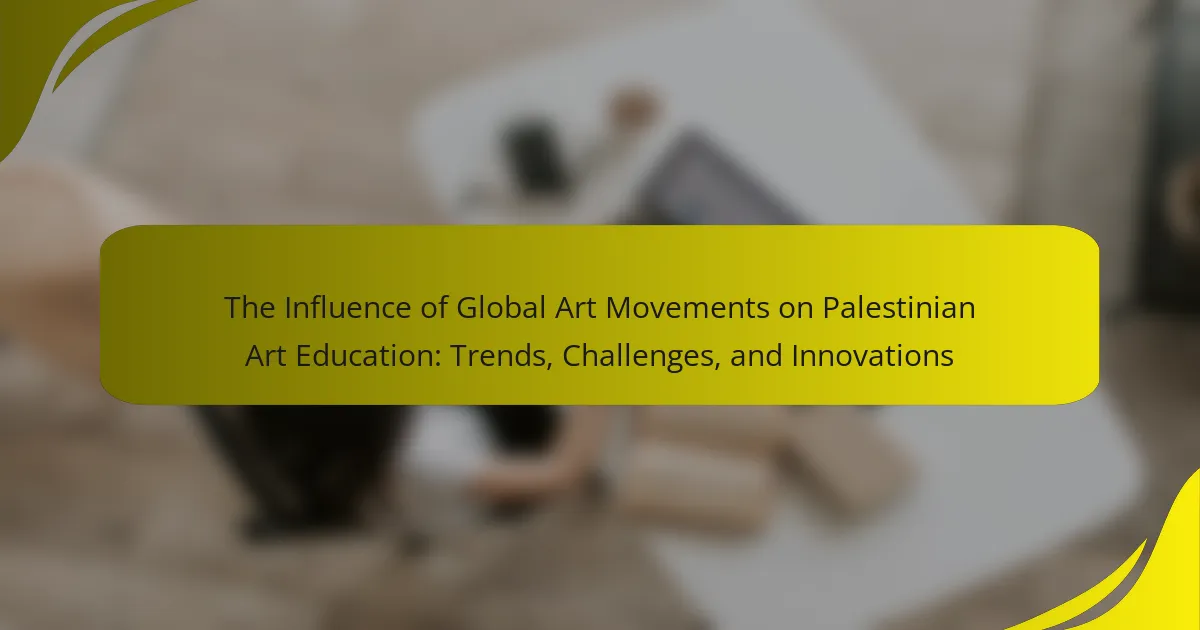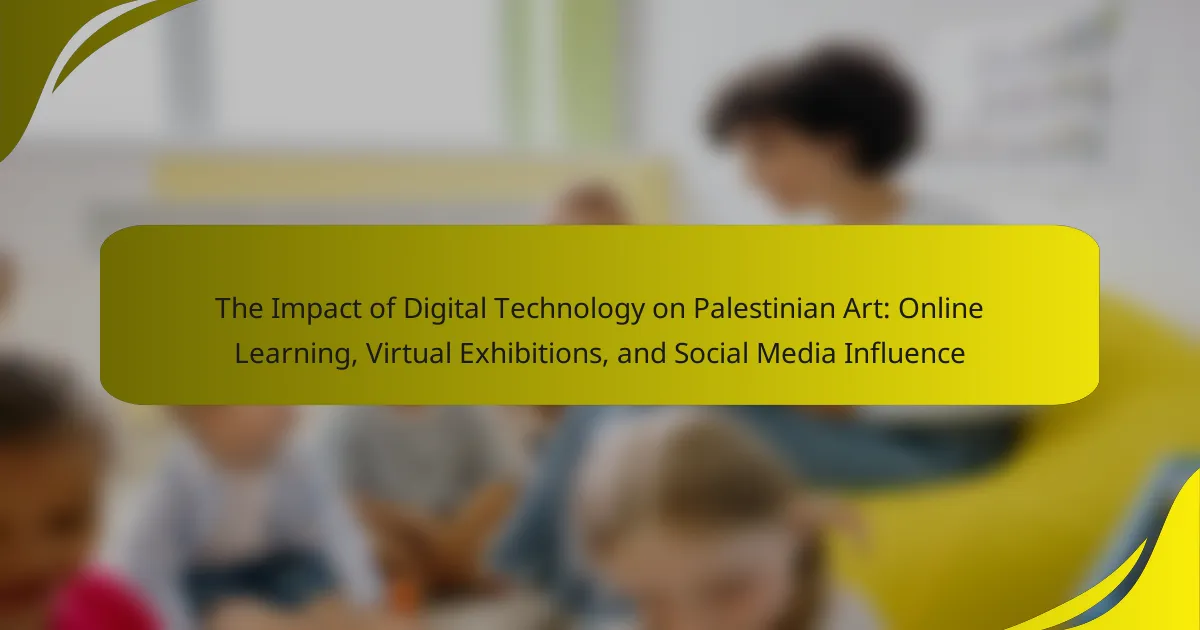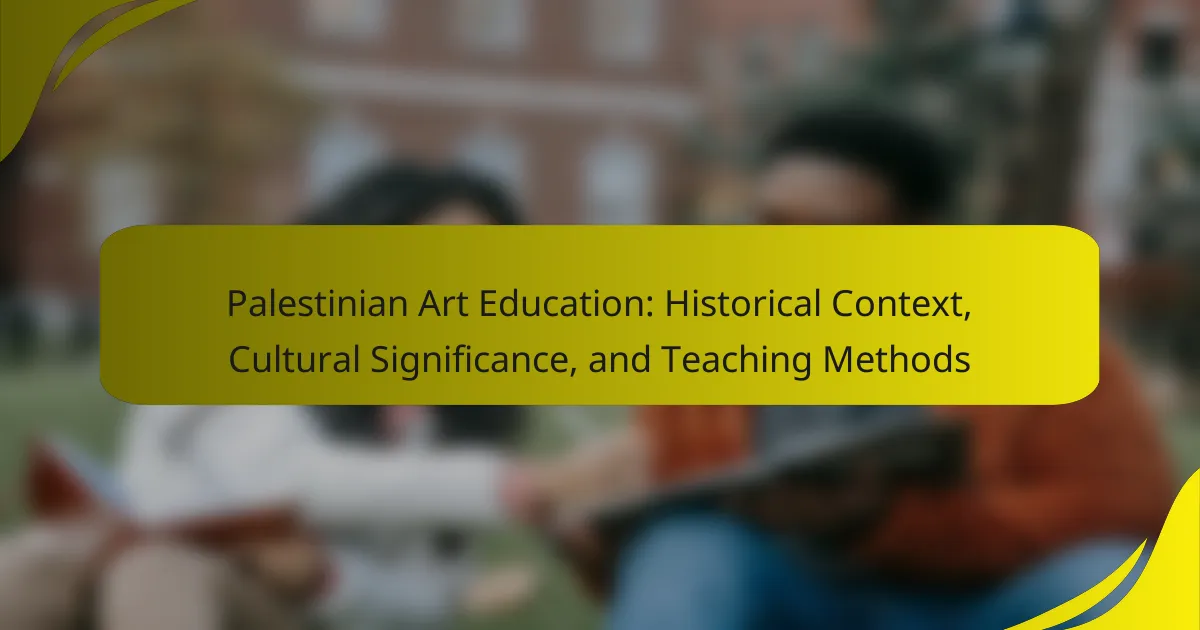Palestinian art is a vital expression of cultural heritage that plays a significant role in identity formation among the Palestinian people. It serves as a medium for storytelling, reflecting the historical and contemporary struggles, resilience, and shared experiences of this community. Various artistic forms, including painting, music, and literature, challenge stereotypes and foster a deeper understanding of Palestinian identity. Community engagement through art initiatives enhances collective identity and promotes civic participation, while events like exhibitions and festivals encourage local talent and dialogue. Overall, Palestinian art is integral to preserving cultural identity and asserting resilience in the face of adversity.
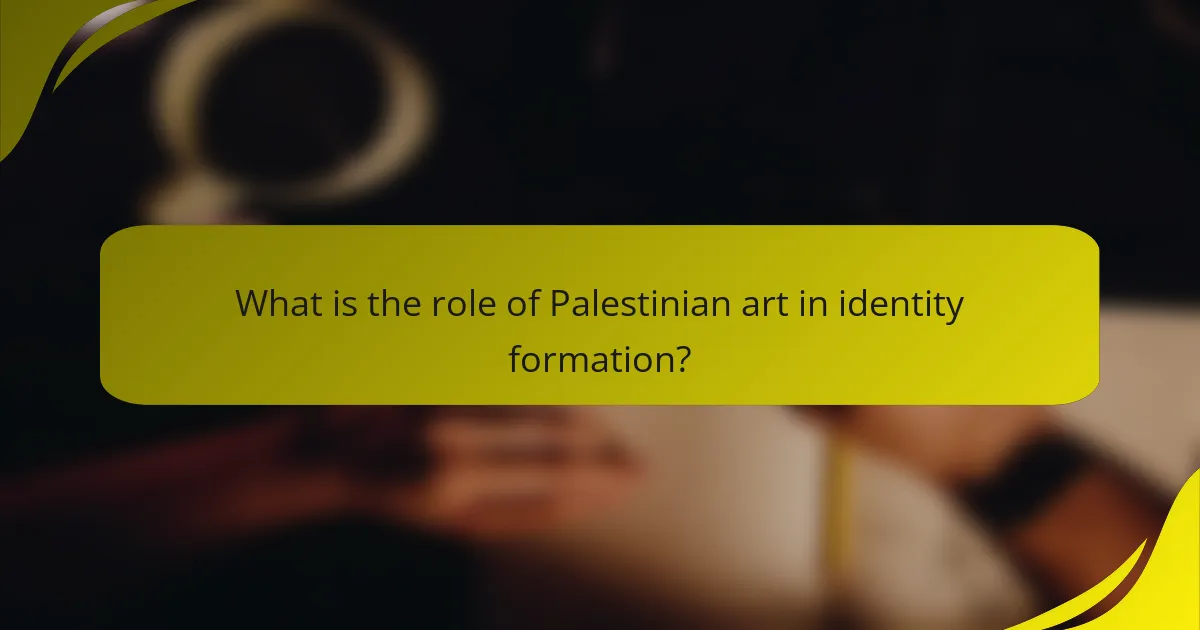
What is the role of Palestinian art in identity formation?
Palestinian art plays a crucial role in identity formation by expressing cultural heritage and shared experiences. It serves as a medium for storytelling, reflecting the historical and contemporary struggles of the Palestinian people. Through various forms such as painting, music, and literature, artists convey messages of resilience and resistance. This artistic expression fosters a sense of belonging and unity among Palestinians. Art also challenges stereotypes and misconceptions about Palestinian identity. By showcasing diverse narratives, it promotes a deeper understanding of their culture. Notably, exhibitions and festivals often engage the community, reinforcing collective identity. Overall, Palestinian art is integral to preserving and asserting cultural identity in the face of adversity.
How does Palestinian art express cultural identity?
Palestinian art expresses cultural identity through its themes, styles, and symbols. The art often reflects the historical and social experiences of the Palestinian people. It incorporates traditional motifs and stories that resonate with the collective memory. Artists use various mediums, including painting, sculpture, and performance, to convey their narratives. The use of colors and patterns often draws from the Palestinian landscape and heritage. Art serves as a form of resistance against oppression and a means of asserting identity. Events like the Palestine International Festival showcase the diversity of Palestinian artistic expression. This art fosters a sense of community and belonging among Palestinians, both locally and in the diaspora.
What themes are prevalent in Palestinian art?
Prevalent themes in Palestinian art include identity, resistance, and displacement. These themes reflect the historical and socio-political context of Palestine. Artists often explore the struggle for self-determination through their work. The theme of identity is expressed through cultural symbols and heritage. Resistance is depicted as a response to occupation and oppression. Displacement highlights the experiences of refugees and loss of homeland. Many artworks convey emotions tied to these experiences, fostering a sense of community. The themes resonate globally, raising awareness about Palestinian narratives.
How do historical events influence artistic expression?
Historical events significantly influence artistic expression by shaping the themes, styles, and messages conveyed in art. For instance, the Palestinian experience of displacement and conflict has led artists to explore identity, resilience, and resistance through their work. The ongoing Israeli-Palestinian conflict has inspired numerous artworks that reflect the struggles and aspirations of the Palestinian people.
Art movements often emerge in response to societal changes and historical contexts. The Intifada, for example, catalyzed a surge in political art that addressed issues of occupation and human rights. Artists use their medium to document history and provoke thought, ensuring that the narratives of marginalized communities are heard.
Exhibitions and public art initiatives serve as platforms for dialogue and healing in the context of historical trauma. Through these expressions, art becomes a vehicle for collective memory and cultural preservation. Therefore, the interplay between historical events and artistic expression is evident in how artists respond to their socio-political environments.
What emotional impacts does Palestinian art have on individuals?
Palestinian art evokes a range of emotional impacts on individuals, fostering feelings of resilience and hope. It often serves as a medium for expressing personal and collective grief. The art reflects the struggles and aspirations of the Palestinian people, creating a sense of connection among viewers. This connection can lead to increased empathy and understanding of the Palestinian experience. Studies show that engaging with Palestinian art can also inspire activism and social change. For instance, artworks often depict themes of displacement and identity, resonating deeply with those affected by similar experiences. The emotional responses elicited by this art can empower individuals to engage with their own identities and histories.
How does art evoke feelings of nostalgia and loss?
Art evokes feelings of nostalgia and loss by representing personal and collective memories. It often captures moments that resonate with viewers’ past experiences. This connection can trigger emotional responses tied to longing for what once was. Visual elements like color, composition, and subject matter play crucial roles in this evocation. For instance, Palestinian art frequently reflects themes of displacement and heritage. The imagery can remind viewers of their cultural roots and shared histories. Studies show that art can activate memory-related brain regions, enhancing feelings of nostalgia. Thus, the emotional impact of art is significant in shaping identity and community connections.
In what ways can art foster hope and resilience?
Art fosters hope and resilience by providing emotional expression and a sense of community. It serves as a medium for individuals to articulate their experiences and struggles. This expression can lead to healing and personal growth. Art also creates shared narratives that strengthen community bonds. For example, Palestinian art often reflects themes of resistance and identity. This representation can inspire collective hope among individuals facing adversity. Moreover, art can serve as a tool for social change, motivating communities to engage in activism. Research shows that engaging with art can improve mental health outcomes, promoting resilience in challenging circumstances.
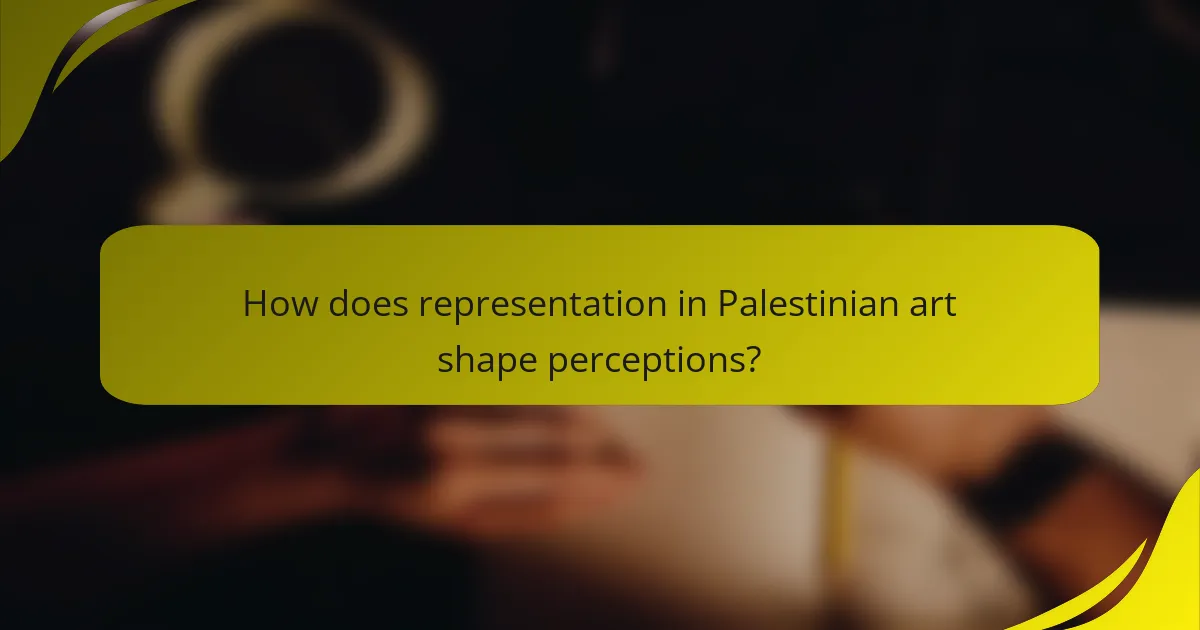
How does representation in Palestinian art shape perceptions?
Representation in Palestinian art significantly shapes perceptions of identity and culture. It serves as a powerful medium for expressing collective experiences and historical narratives. Through visual storytelling, artists convey themes of resilience, loss, and hope. This representation fosters a deeper understanding of the Palestinian struggle. It challenges stereotypes and promotes empathy among diverse audiences. Notable works, such as those by artist Emily Jacir, highlight personal and communal histories. Such art invites viewers to engage with the complexities of Palestinian identity. Consequently, representation in Palestinian art plays a crucial role in influencing public perceptions and awareness.
What role does symbolism play in Palestinian artistic representation?
Symbolism plays a crucial role in Palestinian artistic representation. It serves as a means to express cultural identity and resistance. Artists often use symbols to convey historical narratives and collective experiences. Common symbols include the olive tree, representing peace and resilience. The key is that these symbols resonate deeply within the Palestinian community. They evoke emotions tied to loss, hope, and heritage. Furthermore, symbolism fosters a sense of unity among Palestinians. It connects individuals to their shared history and struggles. This artistic approach strengthens cultural identity amid ongoing challenges.
How are traditional symbols incorporated into contemporary art?
Traditional symbols are incorporated into contemporary art through the use of cultural motifs and historical references. Artists often blend these symbols with modern techniques and materials. This fusion creates a dialogue between past and present. For example, Palestinian artists use traditional patterns and calligraphy to express identity. They reinterpret these elements to comment on contemporary issues. This approach preserves cultural heritage while addressing modern societal challenges. The incorporation of traditional symbols reinforces a sense of belonging and community. It also invites viewers to engage with the artwork on multiple levels.
What messages are conveyed through visual narratives?
Visual narratives convey messages of cultural identity, resistance, and emotional expression. They reflect the experiences and struggles of the Palestinian people. Through imagery, artists communicate historical context and contemporary issues. Visual elements often symbolize hope, resilience, and community solidarity. These narratives foster a connection between viewers and the depicted realities. They challenge stereotypes and promote understanding of Palestinian culture. Studies show that visual art can evoke empathy and inspire action among audiences. This impact reinforces the significance of visual storytelling in shaping identity and community engagement.
How is Palestinian identity portrayed across different art forms?
Palestinian identity is portrayed through various art forms such as visual arts, literature, music, and performance. Visual arts often depict themes of resistance and heritage, using symbolism to convey the struggles of the Palestinian people. For example, artists like Sliman Mansour use traditional motifs to express cultural identity. Literature, including poetry and prose, reflects personal and collective experiences, with writers like Mahmoud Darwish capturing the essence of longing and displacement. Music serves as a medium for storytelling and cultural expression, with genres like folk and hip-hop addressing social issues and uniting communities. Performance art often engages audiences in dialogues about identity, showcasing the resilience and creativity of Palestinian culture. These art forms collectively reinforce a sense of belonging and continuity among Palestinians, making identity a central theme in their artistic expressions.
What are the differences between visual arts and performance arts in representation?
Visual arts and performance arts differ significantly in representation. Visual arts convey ideas through static forms like paintings, sculptures, and photographs. These mediums allow for detailed exploration of themes and emotions through visual elements. Performance arts, on the other hand, involve live action and movement, using actors or dancers to express narratives. This form emphasizes time, space, and the physical presence of the performer.
In visual arts, representation is often interpreted individually and can be revisited multiple times. In contrast, performance arts provide a unique experience that is ephemeral and cannot be replicated. Visual arts can depict complex scenes and abstract concepts, while performance arts often rely on storytelling and audience interaction.
Historically, both forms have played crucial roles in cultural expression. For instance, visual arts have been used to document historical events, while performance arts have served as a means of social commentary. Each medium engages its audience differently, influencing perceptions and emotional responses.
How do artists from diverse backgrounds contribute to the representation of Palestinian identity?
Artists from diverse backgrounds contribute to the representation of Palestinian identity by offering varied perspectives and experiences. Their artworks often reflect personal connections to the Palestinian narrative. This diversity enriches the cultural landscape and fosters a broader understanding of Palestinian experiences. Collaborative projects between artists from different backgrounds can amplify voices that may otherwise be marginalized. For instance, international artists who engage with Palestinian themes can highlight global solidarity. Additionally, these artists often blend different cultural influences, creating a unique fusion that resonates with wider audiences. This representation challenges stereotypes and promotes empathy through shared human experiences. Overall, the contributions of diverse artists highlight the complexity and richness of Palestinian identity.
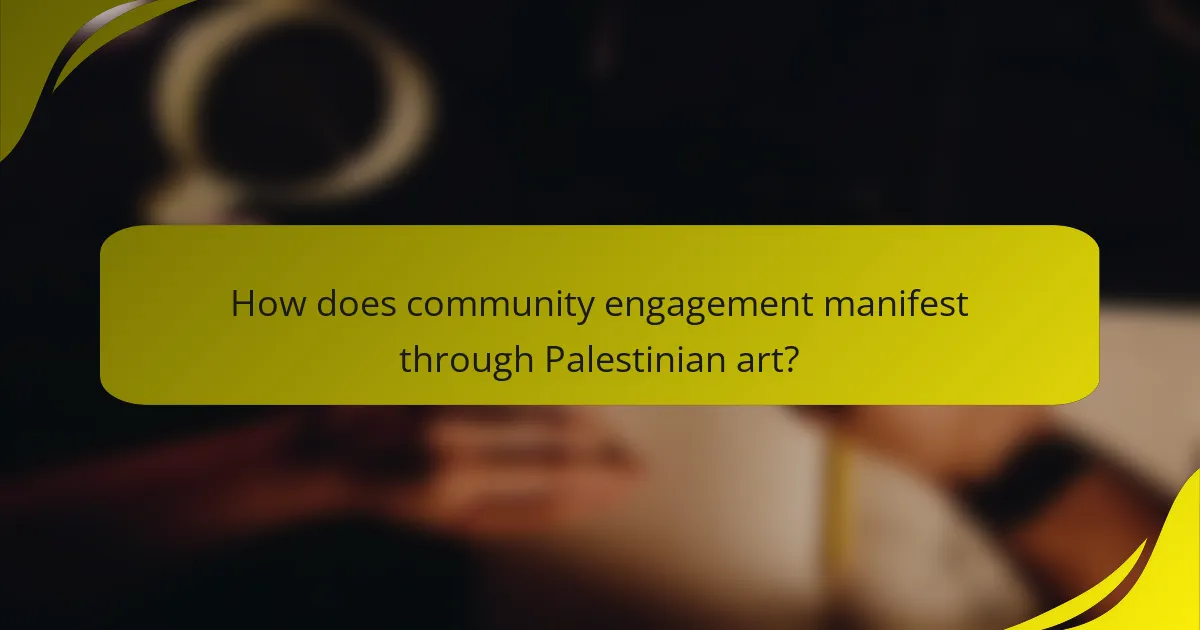
How does community engagement manifest through Palestinian art?
Community engagement manifests through Palestinian art by fostering collective identity and cultural expression. Artists often collaborate with community members to create works that reflect shared experiences and struggles. Public murals and installations serve as platforms for dialogue and awareness. Events like art festivals encourage participation and showcase local talent. Workshops and art classes promote skill development and community bonding. This engagement strengthens social ties and enhances resilience among Palestinians. Research shows that art initiatives can lead to increased civic participation and empowerment in marginalized communities.
What initiatives promote community involvement in the arts?
Community involvement in the arts is promoted through various initiatives. These initiatives include art workshops, community mural projects, and local art exhibitions. They encourage participation from diverse groups within the community. Programs often focus on cultural representation and identity. For instance, organizations may host events that showcase Palestinian artists. This fosters a sense of belonging and pride in cultural heritage. Research indicates that community art projects enhance social cohesion. They also provide platforms for dialogue and expression. Such initiatives are essential for strengthening community ties and promoting artistic engagement.
How do art workshops and collaborations foster local talent?
Art workshops and collaborations foster local talent by providing hands-on experience and mentorship opportunities. These settings encourage skill development through practical engagement with established artists. Participants gain access to diverse techniques and perspectives, enhancing their creativity. Collaborative projects promote networking among artists, fostering a supportive community. This environment nurtures individual expression while emphasizing collective identity. Studies show that local art initiatives increase participants’ confidence and visibility. For instance, a report by the National Endowment for the Arts highlights that community art programs significantly improve artistic skills and local engagement. Thus, art workshops and collaborations are vital for cultivating and sustaining local talent.
What role do public art projects play in community identity?
Public art projects significantly contribute to community identity by reflecting shared values and cultural narratives. They serve as visual representations of a community’s history and aspirations. Such projects foster a sense of belonging and pride among residents. For example, murals and sculptures often depict local stories, enhancing collective memory. Research shows that public art can improve social cohesion and encourage community engagement. Studies indicate that neighborhoods with vibrant public art experience increased interaction among residents. This interaction strengthens community bonds and enhances local identity. Public art projects also attract visitors, boosting local economies and further establishing a community’s unique character.
How does Palestinian art facilitate dialogue within communities?
Palestinian art facilitates dialogue within communities by expressing shared experiences and cultural narratives. This art often reflects themes of resistance, identity, and heritage. It serves as a medium for storytelling, allowing individuals to connect through common histories. Workshops and exhibitions encourage participation and collaboration among community members. Such activities foster understanding and empathy across diverse groups. Art initiatives also create safe spaces for open conversations about social issues. According to a study by the Palestine Museum, community art projects enhance social cohesion and collective identity. This highlights the role of art in bridging divides and promoting dialogue.
In what ways does art serve as a medium for social change?
Art serves as a powerful medium for social change by raising awareness, provoking thought, and inspiring action. It communicates complex social issues in accessible forms. For example, visual art can depict the struggles of marginalized communities. This representation fosters empathy and understanding among viewers. Music and performance art can mobilize audiences to engage in activism. Historical movements, such as the Civil Rights Movement in the U.S., used art to convey messages of justice and equality. Palestinian art, in particular, highlights the experiences and identity of its people. It challenges stereotypes and promotes cultural heritage. Through exhibitions and public displays, art can create dialogue and encourage community engagement.
How can art promote understanding and solidarity among different groups?
Art promotes understanding and solidarity among different groups by fostering empathy and shared experiences. It serves as a universal language that transcends cultural barriers. Through visual storytelling, music, and performance, art conveys emotions and narratives that resonate with diverse audiences. For instance, Palestinian art often reflects themes of resistance and resilience. This allows individuals from various backgrounds to connect with the struggles and aspirations of the Palestinian people. Collaborative art projects can also bring together artists from different communities. These initiatives create dialogue and mutual respect. Studies show that community art programs enhance social cohesion. They encourage participants to explore and celebrate their differences while finding common ground.
What are practical ways to support Palestinian art and artists?
Support Palestinian art and artists by purchasing their work. Buying art directly from Palestinian artists helps sustain their livelihoods. Attend exhibitions and cultural events showcasing Palestinian art. This increases visibility and appreciation for their work. Share Palestinian art on social media platforms. This amplifies their reach and connects them with a broader audience. Collaborate with Palestinian artists on projects. This fosters creative exchange and builds supportive networks. Donate to organizations that fund Palestinian art initiatives. Financial support enables artists to continue their work. Advocate for Palestinian art in educational settings. Incorporating their art into curricula promotes awareness and understanding.
The main entity of the article is Palestinian art, which plays a vital role in the formation of cultural identity among Palestinians. The article explores how Palestinian art expresses shared experiences and historical narratives, fostering a sense of belonging and resilience within the community. Key themes include identity, resistance, and displacement, with an emphasis on how historical events influence artistic expression and evoke emotional responses. Additionally, the article highlights the importance of community engagement through art initiatives that promote dialogue, understanding, and solidarity among diverse groups, ultimately asserting Palestinian identity in the face of adversity.
